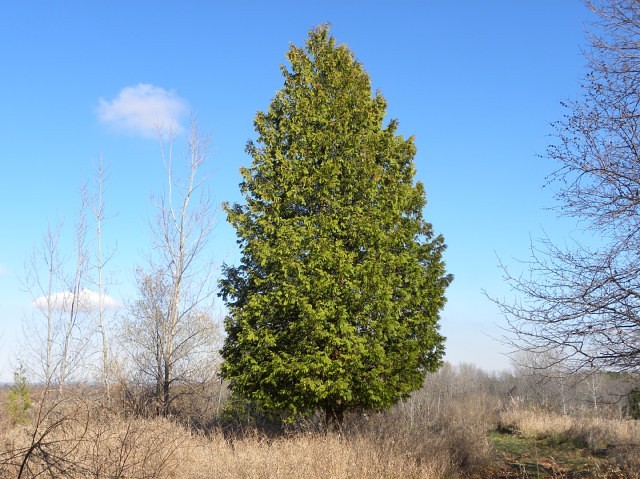Our Favorite Ornamental Trees to Grow in Illinois
Do you want to decorate your Illinois property with beautiful ornamental trees? If so, you’ll be glad to learn that Illinois’s fertile ground and temperate climate make it ideal for cultivating many ornamental tree species.
The prairie grass that once covered much of Illinois has been replaced by three distinct geographic regions: the Central Plains, the Gulf Coastal Plain and the Shawnee Hills. This state enjoys a bounty of natural resources, including arable land, low hills, high heights, rivers, small hilly regions, and a fertile delta.
Illinois has a diverse climate due to the state’s large land area and central location on the continent. The majority of the state, however, experiences a humid continental climate characterized by hot, humid summers and cold, windy winters.
There are a variety of trees that you can plant in Illinois. Here are our favorite ornamental trees to grow in Illinois.
1. Crabapple

- Blooms in the spring.
- Grows to 40 feet in height.
The Crabapple tree is a multipurpose decorative tree with green, oval leaves and clusters of juicy apples in green, red, and yellow. This species is endemic to Asia, Europe, and North America, where it produces clusters of delicate pink and white flowers.
When the ground is wet, and temps are cool, spring and fall are ideal times to grow a crabapple tree. The fall foliage includes a spectrum of colors from red to yellow to orange. This tree prefers partial or full sun and moist, well-drained soils for optimal development.
Nonetheless, you can grow a crabapple any time of the year if you keep the soil from freezing or the temperature from being too high. Although they require full sun to reach their full potential, crabapples can’t stand the heat and perform best in cool summers and harsh winters. As far as they are put in well-drained soil, they will thrive—plant in a well-ventilated area to reduce the risk of foliar diseases.
2. Japanese Lilac
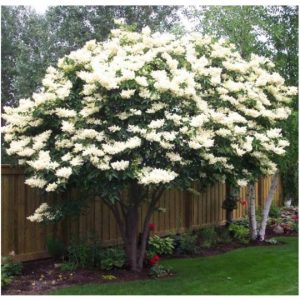
- Blooms in the first part of summer.
- They are typically between 15 and 25 feet in height.
The Japanese Lilac is a tiny, multi-trunked ornamental tree. This tree can be shaped into a single trunk with a little pruning. It has enormous, hanging clusters of fragrant, tiny white blooms, and its dark green foliage provides a striking contrast.
This low-maintenance tree prefers full sun and evenly moist, well-drained soils. Because the Japanese lilac is so unlike the typical lilac, some research into the species is necessary before making a purchase.
It’s not bothered by pests or diseases and even resists powdery mildew better than typical lilac shrubs. Because of its compact size and absence of an invasive root system, lilacs are suitable for planting next to decks, patios, pathways, driveways, and septic lines.
3. Pagoda Dogwood
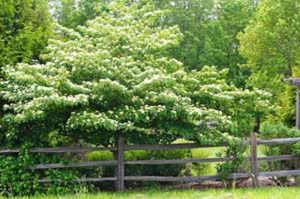
- Blooms during the springtime.
- 30 feet in height.
These trees with alternating leaves, or dogwoods, are indigenous to the eastern United States and Canada and tend to be medium in size. The flowers on these lovely ornamental trees are either a delicate yellow or pure white.
They have azure fruits, horizontally twisting branches, and reddish-purple fall foliage. Pagoda dogwoods require consistently wet soils and do best in partially shaded or shady locations. Pagoda dogwood does best when planted in slightly acidic, moderately damp, well-drained loam soil.
In its original habitat, this tree lives where it can enjoy the dappled shade. The plant can survive in clay soil, though its growth would be stifled there. The average growth rate of this dogwood is 2 ft per year.
Putting down a thick layer of mulch around this tree will help keep the soil moist and enable it to grow effectively.
4. Serviceberry

- Blooms in the spring.
- Ranges ten to twenty-five feet in height.
These trees form hanging clusters of white flowers with five petals and a mild fragrance, followed by tiny, spherical berries in shades of black or purple. The small, oval, dark green leaves of this native of the northeastern United States transform into vibrant shades of orange, red, and yellow in the fall.
Sunlight and slightly acidic, well-drained, consistently moist soil are ideal conditions for a serviceberry tree’s development. White flowers on serviceberry trees appear before the leaves in the spring, making them an early nectar source for pollinators.
Once the flowers have faded, they are replaced by berries that can be eaten. As the season progresses, the berry turns from green at the start of summer to dark red and purple. The berries are delicious, whether eaten fresh or processed into jams and jellies; they are a great blueberry alternative. Even birds like to eat them.
The leaves of the serviceberry have a free and airy texture. As the temperatures drop at night throughout autumn, the once-blue-green foliage turns to brilliant colors of orange and crimson.
5. Seven-Son Flower
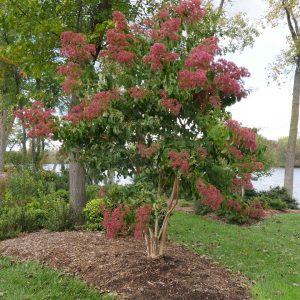
- Blooms throughout the summer.
- 10 ft Height.
The leaves of Seven-Son Flower Trees are narrow and ovate-oblong in shape; they are a medium green color and glossy. The fragrant, white flowers of this multi-stemmed Chinese tree are clustered into seven-branched clusters that form a fountain at the top of the plant.
Seven-Son flower’s thick, glossy leaves measure 4 and 6 inches in length during the growing season. Each branch has six flowers, followed by tiny, crimson fruits. Optimal conditions for this deciduous tree include full sun and well-drained, medium-moisture soils.
Midway through July, the flowers emerge in tight, whorled clusters of seven; this is where the name comes from. The Seven-Son flower is a beautiful sight in spring, summer, fall, and winter, thanks to its striped tanbark.
This tree is in many beautiful gardens and may be a great addition to yours. Tolerant to a wide range of growing situations, this plant can eventually reach heights of 15–20 feet and widths of 10–15 feet. However, Seven-Son Flower should not be cultivated without irrigation, as it may not survive in fairly dry conditions.
6. White Ash
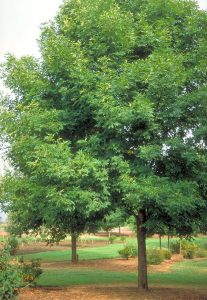
- Blooms during the springtime.
- Ranges in height from 50 feet to 80 feet.
The white ash tree is a native of the eastern United States and Canada. This tall, deciduous tree begins life with a pyramidal structure and broadens into a rounded crown. Clusters of purple flowers without petals are followed by bunches of winged samaras that hang down.
The leaves of this tree are odd-pinnate, dark green on the upper surfaces and lighter green on the lower surfaces. Colors range from purple to green in the autumn. White ash trees thrive in full sun to partial shade and in organically rich, well-drained soils.
White Ash trees have leaves that can be either yellow or red in the fall. White ash is a woodland tree that frequently grows alongside sugar maple, whereas green ash is a dominant species that occupies riparian zones.
White ash is among the most practical trees, and as a result, it is grown practically everywhere. It has long been used to make baseball bats and tool handle timbers. Additionally, the wood works well for making home furnishings and flooring.
7. Sassafras
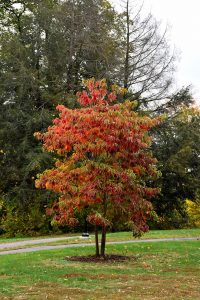
- Blooms during the springtime.
- Size: 30-60 feet in height.
The native Sassafras tree is a medium-sized, attractive, deciduous tree with a thick, pyramidal crown. Clusters of greenish-yellow flowers appear on the plant. Eventually, the blossoms will be replaced by groups of small, hanging, bluish-black berries.
It has brilliant green, oval leaves with three lobes that can vary in shape and size. Great purple, yellow, and crimson autumn colors coat this tree. A sassafras tree’s ideal growing conditions are full or partial sun and acidic, moist, and loamy soils.
Sassafras trees produce a strong and attractive wood used in the construction of ships and furniture manufacturing in North America, Asia, and Europe. Because of its distinctive foliage and pleasant fragrance, Sassafras is frequently used as a landscape tree. It is occasionally grown in European countries and beyond.
Southeastern Native Americans also used sassafras wood for fire-starting due to the natural oils’ flammability in the bark and leaves.
8. Desert Willow
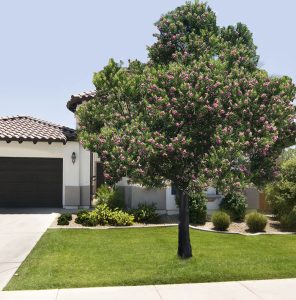
- Timing of blooming: Spring and summer.
- 30 feet in height.
The Desert Willow species, originally from the northern parts of the United States, is a frequently planted natural ornamental tree. This fast-growing, twisted-trunk species is chosen for its unusual purple 5-petaled flowers.
The desert willow is a hardy tree that thrives in sunny, well-drained regions. The unique blooms have yellow and white slashes in their middle. Besides deciding where in your garden to put the strong tree and taking care of its occasional pruning, this plant will be low-maintenance.
The desert willow is a low-maintenance tree. So small that it can exist indefinitely with no effort. Even if you chopped the tree down to the ground, it would regenerate into a healthy shrub in a few short weeks. Your desert willow can be shaped into whatever shape you like by selective pruning.
A garden or other portion of the environment that is drier, warm, and gets more sunlight than the rest or has a lot of water but drains incredibly rapidly, like the top section of a rain garden, is ideal.
9. Yellow Poplar
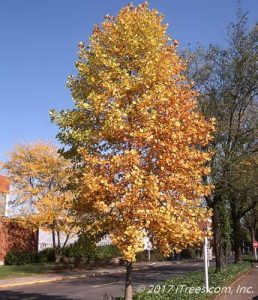
- Time of blooming: late spring/early summer.
- Grows to a height of between 70 and 90 feet.
Yellow Poplar is a majestic poplar tree that originated in eastern North America. It grows to great heights and has a broad cone or pyramid crown. Its yellow flowers are cup-shaped like tulips, distinguished by an orange stripe at the bottom of each petal.
This tree has bright green, four-lobed foliage that become golden yellow in the fall. Flowers are followed by brown, cone-shaped fruits that are rough and dry. Soil that is organically rich, wet, well-drained, and has plenty of sun is ideal for yellow poplar trees.
In their old age, the trunks grow enormous, and the bark becomes severely furrowed. The distinctive leaf of the yellow poplar is divided into four lobes by rounded notches. Midway through spring, the tree bursts into bloom with fragrant, tulip-like, greenish-yellow flowers that are visually striking.
10. Carolina Silverbell
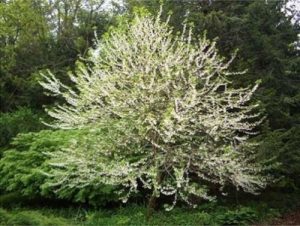
- Blooms during the springtime.
- Size: 30-40 feet in height.
A beautiful and low-maintenance blooming tree, the Carolina Silverbell is worth considering. This native of the southeastern United States is endowed with a broad, rounded crown and bears bunches of 2 to 5 white, bell-shaped flowers.
The ovate, yellowish-green leaves of this tree are finely toothed. In spite of its somewhat fragile look, Carolina Silverbell is a relatively resilient and easy-to-grow springtime plant that functions as a transitional form between shrubs and a tree and is attractive year-round. It does well in full sun and in acidic, well-drained, wet, rich soils.
As seeds take a long time to germinate, they are typically transplanted from container-grown specimens (obtained from a nursery). Aside from a mildly acidic soil pH level, the only requirement for the Carolina Silverbell is adequate sunlight.
If you can meet those two conditions, you should have a healthy plant that will brighten your environment for years to come. Neither pests nor diseases have caused any significant problems for the plant.
12. Southern Magnolia
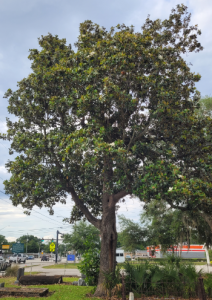
- Blooming Time: Late Spring through Early Summer.
- Grows up to 37 feet in height.
Medium-sized Southern Magnolias are highly prized for their stunning appearance and fragrant white blossoms held in a cup-shaped flower cluster.
This flowering tree is endemic to the United States and has a thick crown, thick robust stems, and dark green leaves with brown bases. This tree prefers dappled or full sun and well-drained soils, organically rich and gently watered.


